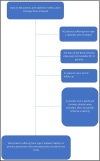Prognostic significance of the renal resistive index in the primary prevention of type II diabetes
- PMID: 32003935
- PMCID: PMC8029971
- DOI: 10.1111/jch.13819
Prognostic significance of the renal resistive index in the primary prevention of type II diabetes
Abstract
The renal resistive index has been demonstrated to predict the progression of renal disease and recurrence of major cardiac events in high-risk cardiovascular patients, in addition to other comorbidities. We aimed to assess the prognostic significance of the renal resistive index in type 2 diabetic patients for primary prevention. From 2008 to 2011, patients with type 2 diabetes underwent cardiovascular evaluation, including renal resistive index assessment by renal Doppler ultrasound. The incidence of all-cause death, cardiovascular events, dialysis requirement or a twofold increase in creatinine was recorded. Survival curves were estimated by the Kaplan-Meier method. Two hundred sixty-six patients were included; 50% of the patients were men, an HbA1C level of 8.1 ± 1.7% (65 ± 13.6 mmol/mol) and a serum creatinine level of 8 [7-9] mg/L. The mean 24-hour systolic blood pressure, 24-hour diastolic blood pressure, and 24-hour pulse pressure were 133.4 ± 16.7, 76.5 ± 9.4, and 56.9 ± 12.4 mm Hg, respectively. The median renal resistive index was 0.7 [0.6-0.7] with a threshold of 0.7 predictive of monitored events. After adjustment of the 24-hour pulse pressure, age and 24-hour heart rate, a renal resistive index ≥0.70 remained associated with all-cause death (hazard ratio: 3.23 (1.16-8.98); P = .025) and the composite endpoint of major clinical events (hazard ratio: 2.37 (1.34-4.18); P = .003). An elevated renal resistive index with a threshold of 0.7 is an independent predictor of a first cardiovascular or renal event in type 2 diabetic patients. This simple index should be implemented in the multiparametric staging of diabetes.
Keywords: diabetes mellitus; prognosis; pulse pressure; renal resistive index.
© 2020 Wiley Periodicals, Inc.
Figures





Comment in
-
Renal resistive index as a novel biomarker for cardiovascular and kidney risk reduction in type II diabetes.J Clin Hypertens (Greenwich). 2020 Feb;22(2):231-233. doi: 10.1111/jch.13817. Epub 2020 Jan 31. J Clin Hypertens (Greenwich). 2020. PMID: 32003929 Free PMC article. No abstract available.
-
Renal resistive index: Beyond the hemodynamics.J Clin Hypertens (Greenwich). 2020 Jul;22(7):1288-1289. doi: 10.1111/jch.13920. Epub 2020 Jul 9. J Clin Hypertens (Greenwich). 2020. PMID: 32644294 Free PMC article. No abstract available.
References
-
- Ogurtsova K, da Rocha Fernandes JD, Huang Y, et al. IDF diabetes atlas. Global estimates for the prevalence of diabetes for 2015 and 2040, 8th edn. Diabetes Res Clin Pract. 2017;128:40‐50. - PubMed
-
- Aboyans V, Tanguy B, Desormais I, et al. Prevalence of renal artery disease and its prognostic significance in patients undergoing coronary bypass grafting. Am J Cardiol. 2014;114(7):1029‐1034. - PubMed
-
- Ennezat PV, Maréchaux S, Six‐Carpentier M, et al. Renal resistance index and its prognostic significance in patients with heart failure with preserved ejection fraction. Nephrol Dial Transplant. 2011;26(12):3908‐3913. - PubMed
-
- Delsart P, Meurice J, Midulla M, Bauters C, Haulon S, Mounier‐Vehier C. Prognostic significance of the renal resistive index after renal artery revascularization in the context of flash pulmonary edema. J Endovasc Ther. 2015;22(5):801‐805. - PubMed
-
- Tublin ME, Tessler FN, Murphy ME. Correlation between renal vascular resistance, pulse pressure, and the resistive index in isolated perfused rabbit kidneys. Radiology. 1999;213(1):258‐264. - PubMed
MeSH terms
LinkOut - more resources
Full Text Sources
Medical

